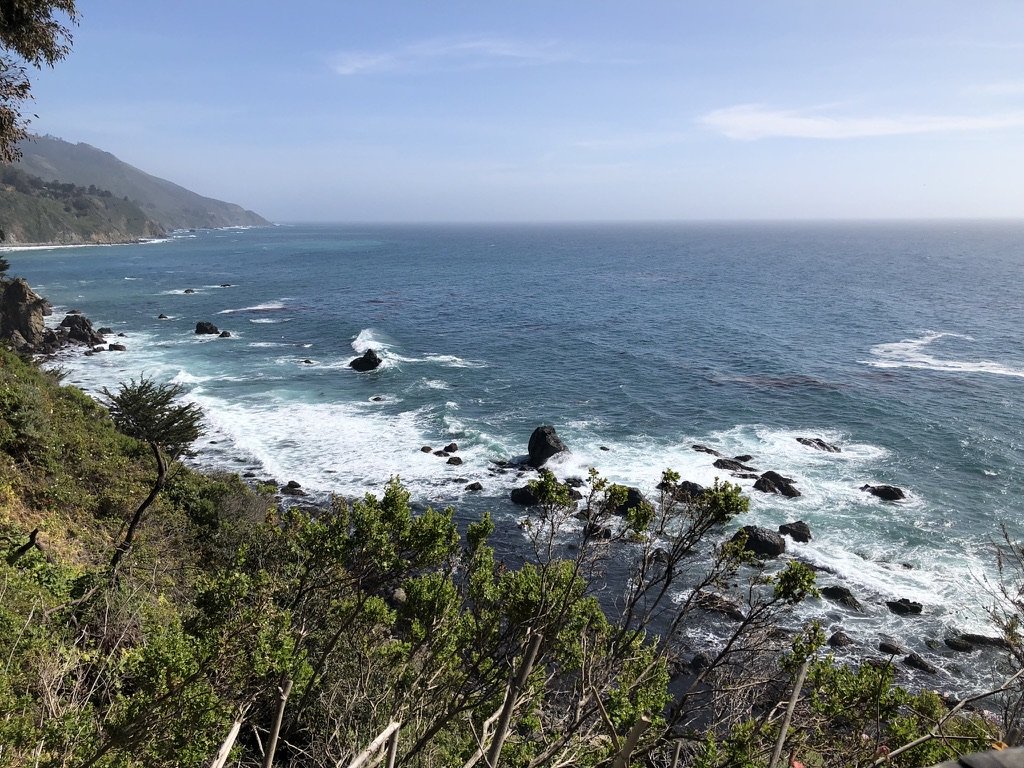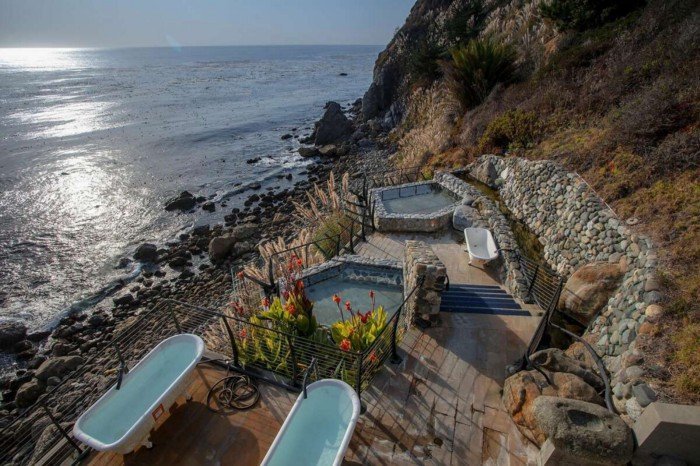Body Awakening at Esalen
I’ve learned not to sweat the small stuff. But sometimes, the small stuff needs to be sweat over … a little. Like when you’re planning a solo retreat to a place called Esalen Institute, home of the Human Potential Movement in the 60s, in Big Sur, California.
Maybe it needs to be more than a quick search for “spiritual retreats near me.” More than just scrolling through the photos of the hot springs terraced into the cliff walls, overlooking the sparkling turquoise waters of the Pacific, and then booking the first available dates.
Because what happens when you don’t read the fine print in these situations is that you realize (too late for a refund) that those steaming natural hot springs that called out to you from the photos—end up being nude baths. Co-ed nude baths.
Then again, a little less planning leaves room for serendipity and life happening in all its unexpected and divergent ways, which I was ready for.
For the past 10 years, I had been living like a cloistered monk, exploring and re-cultivating my mind and emotions through quiet, still, inward introspection and prayer. It was time for life to be in session.
From the start, it felt like nature’s elements at Esalen were designed to disrupt and dislodge standard operating procedure. From the force of the waves pounding against the rocks below, to the winds that whip through your hair, to the sulfuric smells and roiling waters of the hot springs. You are thrown off kilter on the cliffs of Esalen. But those of us that seek this out know that releasing control is a necessary first step to transformation.
Esalen’s Hot Springs
My first visit to the baths was at night, naturally. Swimsuits are optional, but no one wears them, I learned. Hoping to avoid people as much as possible, I chose a steaming pool in the farthest corner overlooking the waves spouting on the rocks below. Across the sky, the expanse of stars took my breath away. It was unbelievable.
It turned out, though, that just beyond the reach of the dim lights, there was a man in the pool with me. He was friendly and chatty—not threatening in any way since the people who come to Esalen respect that we’re all here for the same reason—for healing and personal discovery. He was relaxed and affable in a way one might be in a supermarket line or at the dog park.
As he was leaving he wanted to show me how to adjust temperature of the pool by opening and closing the flow of spring water with a wooden dowel. He stood up out of the water in his full nakedness to show me—bending over and balancing on one leg to plug and unplug the spout. It was a lot.
So my first visit to the bath was uncomfortable. But I told myself that was ok, I was done beating up on myself and everyone else. That’s what this week was about, right?
The next day, I thought maybe ripping off the bandaid might be better, so I headed to the baths again, this time in full midday sun. I disrobed and moved toward the same pool in the far corner, this time passing dozens of people.
With each step, my face started to warm, quickly turning into a full burn. By the time I got to the pool, hot tears were streaming down my face and neck, and I entered the bath with my eyes squeezed shut.
As I sat there, I was overwhelmed with an intense shame, emanating from my lower belly. I sat in that bath for over an hour with my eyes closed, quietly weeping, naked and completely vulnerable, willing myself to stay open to the reckoning I sensed coming. Again, it was a lot, but I wasn’t on my own. My higher power was a gentle presence there with me, encouraging me on, guiding the way.
Maybe it had been too much too fast, or maybe just what I needed. But it started an undoing that continued throughout the week and then for months after.
Exploring Healing at Esalen
Along with communal nude bathing, I took part in various experiences—free dance, chakra meditation, Gestalt therapy, sound bathing—all letting my body and my senses take the lead. And my mind took a back seat, simply paying attention while long held ideas, beliefs, and programming surfaced with intensity. They arose as a full body experience and seemed to work their way out physically through my muscles, my fingers, my feet, my skin, my breath, my tears.
Wise people have taught me that things show up in a strong way when they want to be looked at and are ready to be released at a deeper level. Until we do, they stay embedded in us, like skin tags, rooted into the flesh.
Without planning it, I had set up this time to make amends to my body.
My week at Esalen was about freeing my body from debilitating shame, judgment and self-consciousness. From distorted perceptions, never being good enough, constant criticism and unreasonable expectations—mostly coming from myself at this stage in my life (if I’m honest). Yes, I was my body’s harshest critic. Maybe I’d acquired that voice from the outside, from my mother, from the media. But I had to face my part as the one whose voice continued to play on loop, even when my mother had stopped.
Body reconciliation is an essential step to living fully and freely at any age, and especially crossing over midlife. Puberty was our body’s first rite of passage. As adults, we get another opportunity, another bodily transition into the next epoch of our lives. We can do this in self-deprecation and humiliation over our bodies’ changes, or we can pass through with unapologetic self-acceptance so that we can enjoy this life, like poet Kate Baer says, “opening it like a peach in season.”
As with any evolution, there’s work to be done. We can experience body reconciliation in a lot of different ways. Be sure to talk to a trusted mentor or practitioner to guide you through. But here’s something you can try at any time.
Self-compassion Practice for Body Reconciliation:
Notice when you’re saying or feeling something critical about yourself in relation to your body.
Pause the thought. Take a breath. Then imagine a younger version of yourself (or a young person in your life) being told the things you were just thinking about yourself.
Riding the wave of self-compassion that comes from that, try saying this prayer to yourself slowly, maybe even with your hands gently over your chest:
“I’m sorry. Please forgive me. Thank you. I love you.”
(A spiritual mentor taught me this Polynesian prayer—used to heal and reconcile conflicts in relationships, family or the community. It totally works on yourself, too!)
As you practice this, your body will start trusting you, communicating with you, feeling safe enough to come forward in remarkable ways. It may take some time, attention, the help of a practitioner and maybe even grand gestures like a week-long retreat focusing solely on your body (communal nude bathing not required, but highly recommended).
Living in full bloom is about reconciling with your body, being its best advocate in new and uncharted waters. It starts with disrupting habitual patterns of thought, being willing to look unflinchingly at your relationship with your body, and listening to it with a grace that can only come from a higher place. Remember, you’re not alone.

